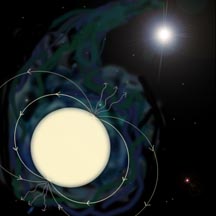RXTE Discoveries
RXTE Gathers More Clues About the Nature of Pulsars - January 7, 1999
by Christopher Wanjek
|
Astronomers observing the "Bursting Pulsar" have used RXTE to gain new insight into its unique mechanisms. The Bursting Pulsar, also known as GRO J1744-28, is the only pulsar known to generate both regular pulses and release frequent, enormous bursts of radiation. The determination of the relationship between these two phenomena may help astronomers to better understand the pulsing mechanism behind other pulsars and how this mechanism is affected by things like strong magnetic fields, companion stars, and occasional bursts of radiation. The Bursting Pulsar was previously featured in our June 1996 Discovery article.
|  |
Dr. Michael Stark of NASA/GSFC and University of Maryland, College Park) and Dr. Keith Jahoda also of NASA/GSFC presented the results of their discovery at the January meeting of the American Astronomical Society (AAS) Meeting in Austin, TX.
A pulsar is a rapidly spinning neutron star that is characterized by very regular pulses of radiation; what makes GRO J1744-28 unusual is that each pulse comes 20 milliseconds later than expected. Dr. Stark has spent the last two years trying to figure out the cause of this pulse delay.
Dr. Stark said that in 1996, large bursts of radiation emitted by GRO J1744-28 caused the delays in its pulse signals. Other pulsars are known to have glitches, or sudden changes in a normally regular pulsation cycle. These are thought to be caused by internal changes in the neutron star. "Understanding this interaction could help us answer lingering questions about what causes glitches in other circumstances and exactly what causes a neutron star to emit large, short bursts of radiation."
Dr. Stark explained the bursts in GRO J1744-28 to be enormous flashes of X-rays, each lasting only a few seconds, emitted by the star once or twice an hour. These flashes were in addition to the pulses of radiation the star emits twice every second. These flashes, or bursts, have only appeared twice, in the early months of 1996 and of 1997. "The curious thing," commented Dr. Stark, "was that the delay in the regular pulsation didn't go away when the bursts went away. This is significant because it suggests that the bursts trigger the delay, but some other process causes the delay itself." Said Dr. Stark in an exclusive interview, "We just don't understand how it works."
But Dr. Stark and others are beginning to make some progress in understanding the strange phenomena of this pulsar. He adds, "We are now at the point of understanding the fuse without understanding the bomb. I'd like to understand the bomb." Dr. Stark now believes that while internal changes within the neutron star play a role in the delayed pulse signals of other neutron stars, that the source of GRO J1744-28's pulse delay is actually external to the star. For example, the X-rays emitted by the neutron star are possibly either being bent by material surrounding the star, or are leaving the surface of the star in a different direction than usual.
When one describes a pulsar, it is usually compared to a light house. This is because a pulsar, the end creation of the supernova explosions of some massive stars, spins rapidly. The pulsar's spin causes the "hot spots" created at the pulsar's magnetic poles by its strong magnetic field, to emit radiation at regular intervals. As the pulsar spins, the radiation that leaves the star appears beam-like, much like the rotating lantern in a lighthouse. This lighthouse analogy can be extended in the case of GRO J1744-28. When the pulse signal is delayed, it is either because something moved the lantern in the lighthouse, or because the beam of light is being bent after it is emitted from the lighthouse by some kind of "mirror" suspended nearby.
Early analysis of GRO J1744-28 favored the motion of the hotspot on the neutron star - that is to say, something was moving the lantern. But the analysis that was presented at the AAS meeting appears to rule that out in favor of the theory that suggests the X-rays are bent as they leave the pulsar. "We still haven't found what it is that is acting like a mirror redirecting these X-rays, but at least now we know we are looking for one." Several possibilities exist - one is the disk of material around GRO J1744-28 formed by gravitational interaction with the other star in its binary system. This disk, known as an accretion disk, may be responsible for bending the X-rays, although it will take more work to learn if this theory is correct.


